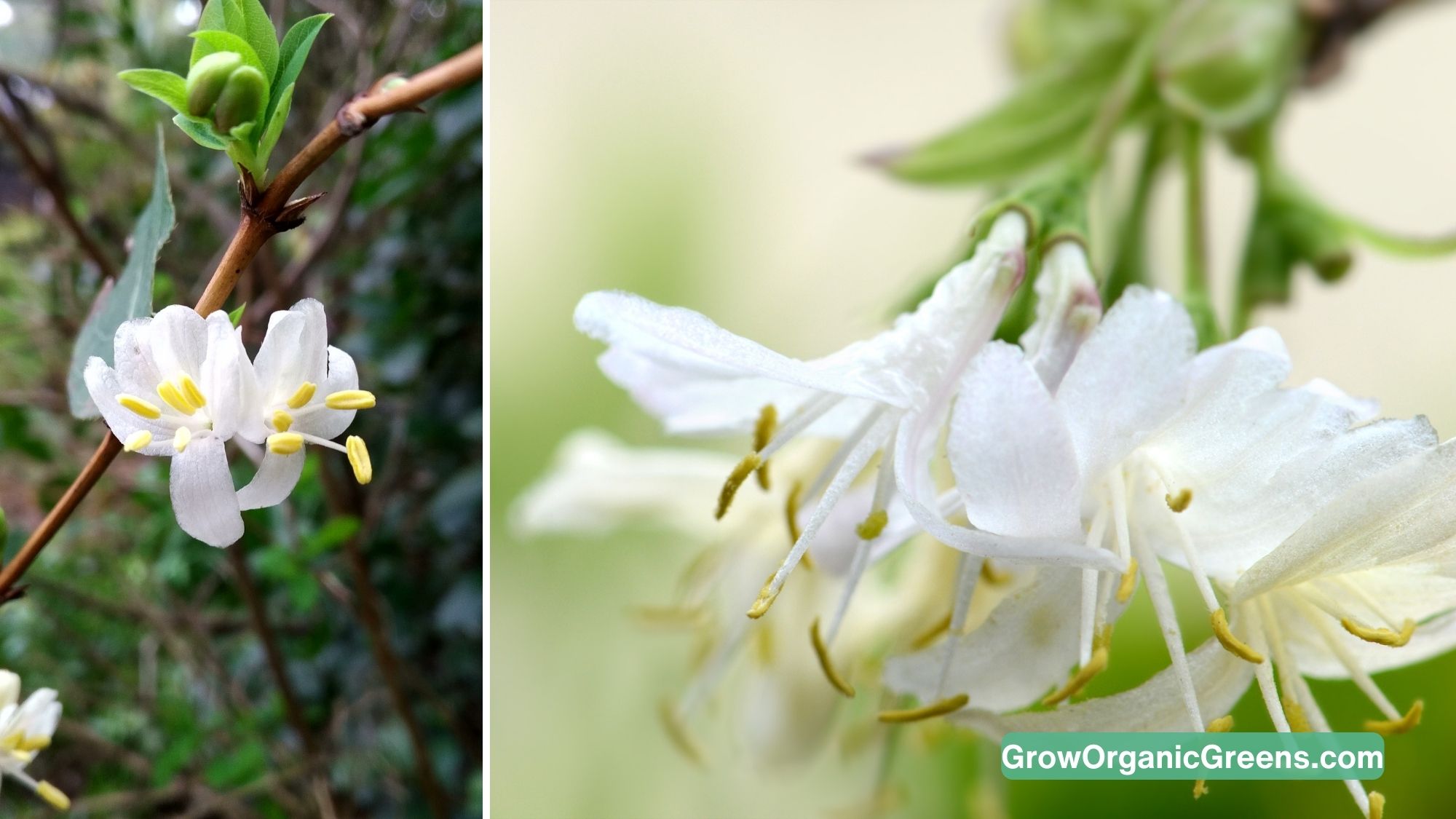Winter Honeysuckle is a delightful perennial shrub known for its fragrant blooms during the colder months. This guide will provide you with all the essential information on how to grow and care for this charming plant, ensuring it thrives and adds beauty to your garden. To explore more about growing honeysuckle, check out our comprehensive guides on how to grow and care for honeysuckle and popular varieties of honeysuckle.
How Does It Look?
Winter Honeysuckle features small, white to creamy-yellow flowers that are highly fragrant, making it a standout during the winter season. The buds are small and white before opening into these aromatic blooms. The leaves are green, oval, and semi-evergreen, providing a lush backdrop that lasts through much of the year.
Native
Native to China, Winter Honeysuckle has been cherished for its winter blooms and aromatic qualities.
Hardiness Zones
4-8 (USDA). Search your hardiness zone.
Annual/Biennial/Perennial
Winter Honeysuckle is a perennial shrub, offering year-round beauty. For more perennial plant ideas, consider our guide on 36 low maintenance potted plants.
Requirements at the Time of Plantation
This honeysuckle prefers well-drained, fertile soil and can be planted in locations with full sun to partial shade. The best times for planting are in spring or fall to ensure the shrub establishes well before extreme weather conditions. To prepare your soil optimally, refer to our resource on soil testing for garden.
Blooming Season
Winter Honeysuckle blooms from late winter to early spring, providing much-needed color and fragrance when most other plants are dormant.
How to Take Care
For optimal growth, plant Winter Honeysuckle in an area that receives full sun to partial shade. Apply a balanced fertilizer in early spring to promote healthy growth. Regular watering is essential, particularly during dry conditions, to keep the soil consistently moist but not waterlogged. Discover efficient watering practices with our guides on how often should you water your garden and best watering system for raised bed garden. Using organic mulch helps retain soil moisture and suppress weeds.
Companion planting with other early-blooming shrubs can create a visually appealing garden and promote a healthy growing environment. The winter blooms and sweet fragrance of Winter Honeysuckle make it an excellent choice for decorative purposes. Learn more about companion planting strategies for a harmonious garden.
Uses
- Aesthetic: Winter Honeysuckle is appreciated for its winter blooms and sweet fragrance, making it a favorite for gardens and landscapes during the colder months.
- Medicinal: This variety has limited medicinal uses, typically in traditional practices.
- Culinary: Winter Honeysuckle is not used for culinary purposes.
How to Propagate
Propagation can be achieved through cuttings. Take cuttings from healthy, established plants and root them in well-draining soil. For detailed propagation techniques, refer to our pruning, deadheading, and pinching essential plant care guide.
Problems and Organic Solutions
Common pests include aphids and spider mites, which can be controlled using organic pesticides like neem oil or insecticidal soap. Powdery mildew is another potential issue, manageable by ensuring good air circulation and applying organic fungicides if necessary.
Special Facts
Winter Honeysuckle is celebrated for its ability to bloom during the winter months, providing much-needed color and fragrance when most other plants are dormant. Its sweet scent attracts early pollinators, adding ecological value to its aesthetic appeal.
Conclusion
Incorporating Winter Honeysuckle into your garden can provide both visual and aromatic pleasure during the colder months. With its fragrant winter blooms, relatively easy care requirements, and semi-evergreen foliage, this perennial shrub is a wonderful choice for gardeners looking to enhance their outdoor spaces year-round. Ready to enjoy the winter blooms and sweet scents of Winter Honeysuckle? Start planting today and watch your garden come to life even in the coldest season.
Quick Facts Table
| Aspect | Details |
| Appearance | Small, white to creamy-yellow flowers; green, oval, semi-evergreen leaves |
| Native | China |
| Hardiness Zones | 4-8 (USDA) |
| Lifespan | Perennial |
| Plantation Requirements | Well-drained, fertile soil; full sun to partial shade; plant in spring/fall |
| Blooming Season | Late winter to early spring |
| Care Needs | Full sun to partial shade; balanced fertilizer in early spring; regular watering; organic mulch; companion planting with early-blooming shrubs |
| Uses | Winter blooms; sweet fragrance; limited traditional medicinal uses |
| Propagation | Through cuttings |
| Problems & Solutions | Aphids and spider mites (neem oil, insecticidal soap); powdery mildew (good air circulation, organic fungicides) |
| Special Facts | Winter blooms; attracts early pollinators with its fragrance |

Misty S is the founder and lead writer at GrowOrganicGreens.com, a comprehensive gardening resource dedicated to helping people cultivate beautiful and sustainable gardens. She has a Master’s degree in Economics and specialized studies in agricultural economics, horticulture, and soil science. Drawing from her extensive knowledge and experience, Misty shares practical gardening tips on soil preparation, organic manure composting, fertilizers, plant care, and indoor gardening, making her advice accessible and helpful to gardeners of all levels.
Despite having an high-demanding 9-5 job, Misty dedicates her personal time to researching and exploring various gardening topics. Her keen interest in gardening has grown into a passion, driving her to help new gardeners and anyone interested in starting their gardening journey.
Follow Misty’s work and the latest gardening insights and updates on Pinterest. You can reach out to Misty at mistysblogging@gmail.com.

